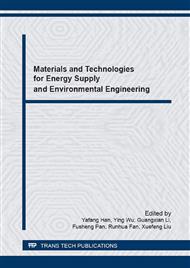[1]
L. Suganthi, A.A. Samuel, Energy models for demand forecasting—A review, Renewable and Sustainable Energy Reviews, 16 (2012) 1223-1240.
DOI: 10.1016/j.rser.2011.08.014
Google Scholar
[2]
X. Tang, L.A. Francis, L. Gong, F. Wang, J. -P. Raskin, D. Flandre, S. Zhang, D. You, L. Wu, B. Dai, Characterization of high-efficiency multi-crystalline silicon in industrial production, Solar Energy Materials and Solar Cells, 117 (2013).
DOI: 10.1016/j.solmat.2013.06.013
Google Scholar
[3]
A.D. Compaan, Photovoltaics: Clean power for the 21st century, Solar Energy Materials and Solar Cells, 90 (2006) 2170-2180.
DOI: 10.1016/j.solmat.2006.02.017
Google Scholar
[4]
W. Hoffmann, PV solar electricity industry: Market growth and perspective, Solar Energy Materials and Solar Cells, 90 (2006) 3285-3311.
DOI: 10.1016/j.solmat.2005.09.022
Google Scholar
[5]
J.M. Kim, Y.K. Kim, Growth and characterization of 240kg multicrystalline silicon ingot grown by directional solidification, Solar Energy Materials and Solar Cells, 81 (2004) 217-224.
DOI: 10.1016/j.solmat.2003.11.020
Google Scholar
[6]
N. Chen, S. Qiu, B. Liu, G. Du, G. Liu, W. Sun, An optical microscopy study of dislocations in multicrystalline silicon grown by directional solidification method, Materials Science in Semiconductor Processing, 13 (2010) 276-280.
DOI: 10.1016/j.mssp.2010.12.006
Google Scholar
[7]
Y. Zhang, Z. Li, Q. Meng, Z. Hu, L. Liu, Distribution and propagation of dislocation defects in quasi-single crystalline silicon ingots cast by the directional solidification method, Solar Energy Materials and Solar Cells, 132 (2015) 1-5.
DOI: 10.1016/j.solmat.2014.08.022
Google Scholar
[8]
H. -j. Su, J. Zhang, L. Liu, H. -z. Fu, Preparation, microstructure and dislocation of solar-grade multicrystalline silicon by directional solidification from metallurgical-grade silicon, Transactions of Nonferrous Metals Society of China, 22 (2012).
DOI: 10.1016/s1003-6326(11)61499-4
Google Scholar
[9]
C.W. Lan, W.C. Lan, T.F. Lee, A. Yu, Y.M. Yang, W.C. Hsu, B. Hsu, A. Yang, Grain control in directional solidification of photovoltaic silicon, Journal of Crystal Growth, 360 (2012) 68-75.
DOI: 10.1016/j.jcrysgro.2012.01.007
Google Scholar
[10]
K. Fujiwara, W. Pan, N. Usami, K. Sawada, M. Tokairin, Y. Nose, A. Nomura, T. Shishido, K. Nakajima, Growth of structure-controlled polycrystalline silicon ingots for solar cells by casting, Acta Materialia, 54 (2006) 3191-3197.
DOI: 10.1016/j.actamat.2006.03.014
Google Scholar
[11]
I. Brynjulfsen, K. Fujiwara, N. Usami, L. Arnberg, Growth velocity and grain size of multicrystalline solar cell silicon, Journal of Crystal Growth, 356 (2012) 17-21.
DOI: 10.1016/j.jcrysgro.2012.06.040
Google Scholar
[12]
G. Stokkan, Relationship between dislocation density and nucleation of multicrystalline silicon, Acta Materialia, 58 (2010) 3223-3229.
DOI: 10.1016/j.actamat.2010.01.042
Google Scholar
[13]
I. Yonenaga, Dislocation–impurity interaction in Si, Materials Science in Semiconductor Processing, 6 (2003) 355-358.
DOI: 10.1016/j.mssp.2003.07.021
Google Scholar


